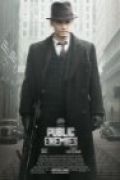
Directed by
Michael Mann
140 minutes
Rated MA
Reviewed by
Bernard Hemingway


Public Enemies
Synopsis: A fictionalized account of bank robber John Dillinger’s 18 month reign as America’s Most Wanted Man.
Public Enemies is everything you would expect from a Michael Mann crime movie: fast-moving, high-powered action delivered with fastidious attention to detail. It is also everything one would hope from the director of a modern exemplar of the genre, Heat (1995). The core premise is essentially the same for both films - a winner-takes-all gangster vs cop fight to the death – and if this version does not have the same bite as the earlier film, it offers different pleasures. The reasons for this are two sides of the same coin.
With Miami Vice (2006) and Collateral (2004), Mann fell short of the benchmark for modern crime film that he set with Heat. Sticking with crime but taking a different tack, Public Enemies is more in the vein of studio-era classics such as White Heat (1949), The Roaring Twenties (1939) and, most pointedly, The Public Enemy (1931) than the full-bodied, contemporary drama of the 1995 De Niro and Pacino stoush. The retro-stylings and legendary characters of the film place it in a fabled past that owes its character more to tabloid journalism and pulp fiction than actual reality albeit with a more modern sensibility, one that recalls the doomed romanticism of Arthur Penn's Bonnie And Clyde (1967) whilst no doubt Mann was familiar with John Milius's grubby 1973 account of Dillinger's story to which plot-wise at least it is quite similar.
Equally, however, it is on the level of style that the film shines. The production design by Nathan Crowley, who, unsurprisingly, did The Dark Knight (2008), is remarkable but never fetishized. DOP Dante Spinotti’s high definition video camerawork is outstanding, yielding imagery that is simultaneously dramatically exaggerated and mesmerizingly convincing in a hyper-real way. Based on a book, Public Enemies: America's Greatest Crime Wave and the Birth of the FBI, 1933-34, by Bryan Burrough, clearly the film has been thoroughly researched and the way in which it transports us into its part-fictional, part-historical (a bulky Billy Crudup plays J Edgar Hoover) universe of Depression-era Chicago is irresistible. Marvellous use is made of locations. Mann shot in the Crown Point jail, the scene of Dillinger’s notorious jailbreak, the Little Bohemia Lodge where Dillinger holed up on his final flight from the law and re-dressed Lincoln Avenue on either side of the Biograph Theatre in a superb re-creation of the night America’s No 1 outlaw died in a hail of bullets. On the big screen, with Mann’s dynamic directing, Public Enemies is, as they say, awesome.
Of course, Depp and Bale are not De Niro and Pacino. Johnny Depp, in a role that was originally slated for Leonardo Di Caprio, is far too well-mannered to convince as a representation of the real Dillinger. But as a screen gangster he is in top form. In my books at least, it is one of his best-ever performances. There is a memorable sequence at the film’s end in which Dillinger goes to the movies to see Clark Gable playing a gangster (the movie was Manhattan Melodrama,1934, this much is historical fact). Depp has an almost-Ed Wood moment as, as Dillinger, he watches the devilishly-handsome star with the pencil moustache just like his own play the defiant-to-the-death anti-hero that he imagines himself to be. Mann and Depp’s Dillinger is definitively revealed as the romantically mythic "lone outsider” figure that is a staple of American fiction, nowhere more evident than on the silver screen. The historical Dillinger is erased as image mirrors image, fantasy merges with fantasy. It is both a brilliant piece of self-aware craftsmanship from Mann and his co-writers, Ronan Bennett and Ann Biderman, and a remarkably poignant moment as we, unlike Dillinger, know that the illusion is about to be shattered in reality by his implacable foe, the Establishment’s willingly punitive agent, Melvin Purvis. Bale is solid as Depp’s dogged antagonist although his character receives nowhere as much attention as the latter's and the actor's attempts to imbue him with conflictual issues, echoed in the film’s end-titles, seem gratuitous and even a tad forced. Although also relatively marginal, Marion Cottilard, a surprising casting choice as Dillinger’s half-caste squeeze, turns in an effectively understated performance. Credit should go as well to Elliot Goldenthal for a score that resonates richly with the narrative’s themes.
Although the plot doesn't always convince (how did Dillinger survive the car accident that claimed Baby Face Nelson one wonders) and dramatically the film is schematic Public Enemies is a top-flight addition to Mann's body of work and stands with the great gangster movies which it so lovingly recalls.
Want something different?





